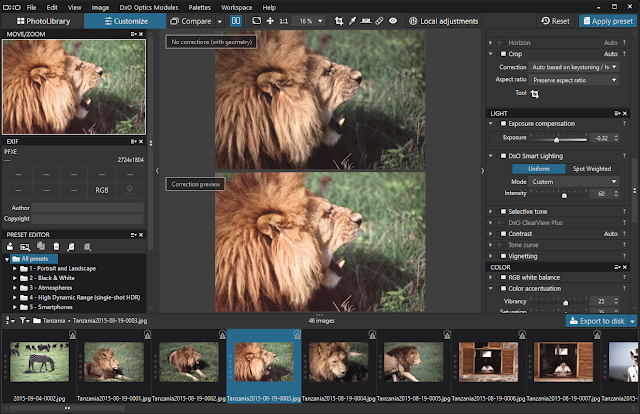

DeepPRIME references millions of images that DxO has collected and analyzed from nearly every type of digital camera ever made.
Review dxo photolab 4 iso#
All digital images have noise, expesically when taken at higher ISO sensitivities. In addition, this version can optimize the photo library with new management tools.ĭeepPRIME is a DxO technology that harnesses deep learning methods to denoise an image. The image library section now has ways of prioritizing keywords using an interactive tree structure. DxOĪlso new in this version of PhotoLab is the ability synchronize changes to an image file’s IPTC and EXIF data by applying the changes to images edited with other third-party applications. However, DxO should perhaps create a bug fix, because the problem with both the watermarks and the denoising tool seem to be well known there.Metadata of individual photos or batches of photos using Photolab 5. ConclusionĭxO Photolab 4 is an all-round success, even if, compared to Lightroom, for example, it lacks a few management features. But then the export takes more than 1 minute. But on most attempts I got an error message when GPU acceleration was activated, so I made most comparisons here only with the CPU. Despite GPU acceleration the export of such an image still takes 5-8 seconds. With a magnifying glass you can only display a small area in real time, and only approximately.Īs you can see from my review of the last DxO version and Denoise AI, I have developed and denoised several images of the Lumix G9 with default settings in both tools.ĭxO is ahead, but in my opinion less than expected. It is only applied to RAW files and only when exporting e.g. The new denoising function is also only available in the Elite version and, as far as we can tell, has been improved once again. DxO reported me wrong format or resolution, although it is a PNG file. But I had problems with my standard logo. PNG should be preferred here because of the transparent background. According to the German manual, you should use either JPG or PNG formats for the images. VIt is also planned to create a preset out of it, which you can then use much easier. They are of course preserved during export and are also displayed in the display window.īoth image and text can be placed anywhere, and you can adjust the opacity of the watermark in the settings. Instant WatermarksĭxO Photolab 4 now allows you to apply watermarks both as text and as an image that are immediately visible. These are displayed in one line, but you can expand the area and see all development settings in detail. This also includes adjustments through presets or copying of development settings. And there is now an improved history of the performed development steps. New is a button in the upper right corner, with which all adjustments already made to the image can be displayed. The histogram has now moved to the right side. Here come the most important changes, that you can create your own workspace with the different development options and of course save it. This is a nice tool, but whether it is reserved for the expensive Elite version is questionable. For example, instead of using the prefix IMG, you can replace it with the job name and assign a consecutive number to the images. With this tool all selected images can be renamed according to a certain scheme. Here you can access the batchrenaming tool by right-clicking.


with GPS data, is only shown in development mode, and there without a map. Nothing significant has changed in the overview, from my point of view there are still missing the meta data (only shown with CRTL-I or when moving the mouse over it) and a kind of grid window.Ĭomplete meta data, e.g.


 0 kommentar(er)
0 kommentar(er)
